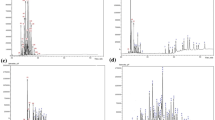Abstract
The thermal stability and composition of the gas phase of Sovol technical mixture of polychlorobiphenyls was studied by synchronous thermal analysis and mass spectrometry in comparison with the derivatives synthesized by the reaction of the congeners with sodium methoxide or with polyethylene glycol in the presence of alkali. The obtained mixtures of methoxy + hydroxy + methoxyhydroxy or hydroxy + poly(ethylene glycol)oxy derivatives of polychlorobiphenyls are less stable thermally than the congeners of the Sovol mixture. In pyrolysis of a mixture of methoxy, hydroxy, and methoxyhydroxy derivatives, the vaporization is accompanied by decomposition with the formation of simple volatile substances. No vaporization is observed in the course of oxidative thermal decomposition of a mixture of hydroxy and poly(ethylene glycol)oxy derivatives. Thermal decomposition of the derivatives requires lower power consumption compared to polychlorobiphenyls and is characterized by decreased emission of hazardous chlorinated compounds.



Similar content being viewed by others
REFERENCES
Erickson, M.D. and Robert, K.G., Environ. Sci. Pollut. Res. Int., 2011, vol. 18, pp. 135−151. https://doi.org/10.1007/s11356-010-0392-1
Treger, Yu.A., Khim. Zh., 2013, no. 1, pp. 30–34.
Porta, M. and Zumeta, E., Environ. Med., 2002, vol. 59, pp. 651−652. https://doi.org/10.1136/oem.59.10.651
Zanaveskin, L.N., Averyanov, V.A., and Treger, Yu.A., Russ. Chem. Rev., 1996, vol. 65, pp. 667–675. https://doi.org/10.1070/RC1996v065n07ABEH000271
Ishikawa, Y., Noma, Y., Yamamoto, T., Mori, Y., and Sakai, S., Chemosphere, 2007, vol. 67, pp. 1383–1393. https://doi.org/10.1016/j.chemosphere.2006.10.022
Trinh, M.M., Kuo, C.H., and Chang, M.B., Chemosphere, 2019, vol. 225, pp. 35–42. https://doi.org/10.1016/j.chemosphere.2019.03.013
Karstensen, K., Mubarak, A., Gunadasa, H., Wijagunasekara, B., Ratnayake, N., Alwis, A., and Fernando, J., Chemosphere, 2010, vol. 78, pp. 717–723. https://doi.org/10.1016/j.chemosphere.2009.11.025
Patent RU 2005519, Publ. 1994.
Wu, B.-Z., Chen, H.-Y., Wang, S.-J., Wai, C.-M., Liao, W., and Chiu, K.-H., Chemosphere, 2012, vol. 88, no. 7, pp. 757−768. https://doi.org/10.1016/j.chemosphere.2012.03.056
Gorbunova, T.I., Subbotina, J.O., Saloutin, V.I., and Chupakhin, O.N., J. Hazard. Mater., 2014, vol. 278, pp. 491−499. https://doi.org/10.1016/j.jhazmat.2014.06.035
Gorbunova, T.I., Pervova, M.G., Saloutin, V.I., and Chupakhin, O.N., Khimicheskaya funktsionalizatsiya polikhlorirovannykh bifenilov: novye dostizheniya (Chemical Functionalization of Polychlorinated Biphenyls: New Achievements), Ural’skii Univ., 2018, pp. 96–260.
De Filippis, P., Scarsella, M., and Pochetti, F., Ind. Eng. Chem. Res., 1999, vol. 38, pp. 380−384. https://doi.org/10.1021/ie9803422
Velazco, M.Z., Pedroso, P.G.V., Ramos, G.V., and Langenhove, H.V., Afinidad, 2013, vol. 563, pp. 206–211.
Joback, K.G. and Reid, R.C., Chem. Eng. Commun., 1987, vol. 57, pp. 233–243. https://doi.org/10.1080/00986448708960487
Goncharova, I.K. and Pestov, S.M., Vestn. Mosk. Inst. Tonk. Khim. Tekhnol., Ser.: Sots.-Guman. Nauki Ekol., 2015, vol. 2, no. 2, pp. 62–67.
Funding
The study was financially supported by the Russian Foundation for Basic Research (project no. 18-29-24126) using the equipment of the Center for Shared Use “Spectroscopy and Analysis of Organic Compounds.”
Author information
Authors and Affiliations
Corresponding author
Ethics declarations
The authors declare that they have no conflict of interest.
Rights and permissions
About this article
Cite this article
Maiorova, A.V., Kulikova, T.V., Safronov, A.P. et al. Thermal Decomposition of Polychlorobiphenyls and Their Derivatives. Russ J Appl Chem 93, 1254–1260 (2020). https://doi.org/10.1134/S1070427220080194
Received:
Revised:
Accepted:
Published:
Issue Date:
DOI: https://doi.org/10.1134/S1070427220080194




